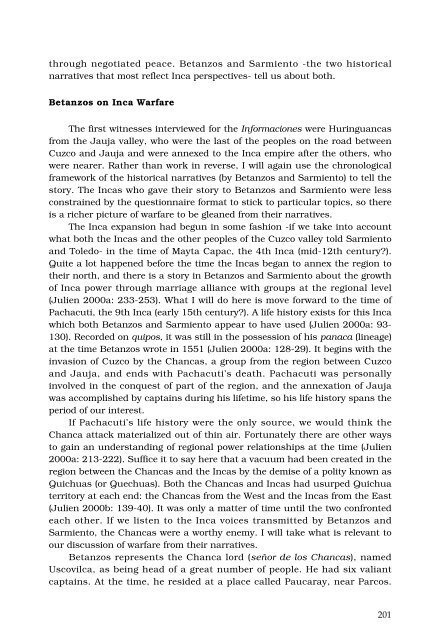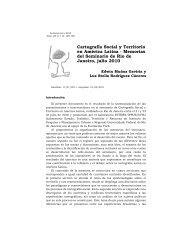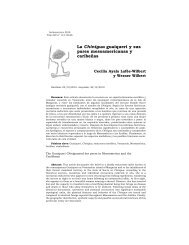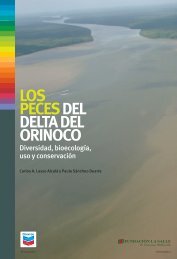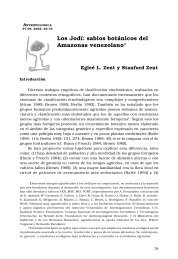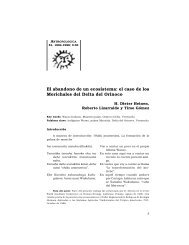War and a Semblance of Peace in the Inca Heartland
War and a Semblance of Peace in the Inca Heartland
War and a Semblance of Peace in the Inca Heartland
You also want an ePaper? Increase the reach of your titles
YUMPU automatically turns print PDFs into web optimized ePapers that Google loves.
through negotiated peace. Betanzos <strong>and</strong> Sarmiento -<strong>the</strong> two historical<br />
narratives that most reflect <strong>Inca</strong> perspectives- tell us about both.<br />
Betanzos on <strong>Inca</strong> <strong>War</strong>fare<br />
The first witnesses <strong>in</strong>terviewed for <strong>the</strong> Informaciones were Hur<strong>in</strong>guancas<br />
from <strong>the</strong> Jauja valley, who were <strong>the</strong> last <strong>of</strong> <strong>the</strong> peoples on <strong>the</strong> road between<br />
Cuzco <strong>and</strong> Jauja <strong>and</strong> were annexed to <strong>the</strong> <strong>Inca</strong> empire after <strong>the</strong> o<strong>the</strong>rs, who<br />
were nearer. Ra<strong>the</strong>r than work <strong>in</strong> reverse, I will aga<strong>in</strong> use <strong>the</strong> chronological<br />
framework <strong>of</strong> <strong>the</strong> historical narratives (by Betanzos <strong>and</strong> Sarmiento) to tell <strong>the</strong><br />
story. The <strong>Inca</strong>s who gave <strong>the</strong>ir story to Betanzos <strong>and</strong> Sarmiento were less<br />
constra<strong>in</strong>ed by <strong>the</strong> questionnaire format to stick to particular topics, so <strong>the</strong>re<br />
is a richer picture <strong>of</strong> warfare to be gleaned from <strong>the</strong>ir narratives.<br />
The <strong>Inca</strong> expansion had begun <strong>in</strong> some fashion -if we take <strong>in</strong>to account<br />
what both <strong>the</strong> <strong>Inca</strong>s <strong>and</strong> <strong>the</strong> o<strong>the</strong>r peoples <strong>of</strong> <strong>the</strong> Cuzco valley told Sarmiento<br />
<strong>and</strong> Toledo- <strong>in</strong> <strong>the</strong> time <strong>of</strong> Mayta Capac, <strong>the</strong> 4th <strong>Inca</strong> (mid-12th century?).<br />
Quite a lot happened before <strong>the</strong> time <strong>the</strong> <strong>Inca</strong>s began to annex <strong>the</strong> region to<br />
<strong>the</strong>ir north, <strong>and</strong> <strong>the</strong>re is a story <strong>in</strong> Betanzos <strong>and</strong> Sarmiento about <strong>the</strong> growth<br />
<strong>of</strong> <strong>Inca</strong> power through marriage alliance with groups at <strong>the</strong> regional level<br />
(Julien 2000a: 233-253). What I will do here is move forward to <strong>the</strong> time <strong>of</strong><br />
Pachacuti, <strong>the</strong> 9th <strong>Inca</strong> (early 15th century?). A life history exists for this <strong>Inca</strong><br />
which both Betanzos <strong>and</strong> Sarmiento appear to have used (Julien 2000a: 93-<br />
130). Recorded on quipos, it was still <strong>in</strong> <strong>the</strong> possession <strong>of</strong> his panaca (l<strong>in</strong>eage)<br />
at <strong>the</strong> time Betanzos wrote <strong>in</strong> 1551 (Julien 2000a: 128-29). It beg<strong>in</strong>s with <strong>the</strong><br />
<strong>in</strong>vasion <strong>of</strong> Cuzco by <strong>the</strong> Chancas, a group from <strong>the</strong> region between Cuzco<br />
<strong>and</strong> Jauja, <strong>and</strong> ends with Pachacuti’s death. Pachacuti was personally<br />
<strong>in</strong>volved <strong>in</strong> <strong>the</strong> conquest <strong>of</strong> part <strong>of</strong> <strong>the</strong> region, <strong>and</strong> <strong>the</strong> annexation <strong>of</strong> Jauja<br />
was accomplished by capta<strong>in</strong>s dur<strong>in</strong>g his lifetime, so his life history spans <strong>the</strong><br />
period <strong>of</strong> our <strong>in</strong>terest.<br />
If Pachacuti’s life history were <strong>the</strong> only source, we would th<strong>in</strong>k <strong>the</strong><br />
Chanca attack materialized out <strong>of</strong> th<strong>in</strong> air. Fortunately <strong>the</strong>re are o<strong>the</strong>r ways<br />
to ga<strong>in</strong> an underst<strong>and</strong><strong>in</strong>g <strong>of</strong> regional power relationships at <strong>the</strong> time (Julien<br />
2000a: 213-222). Suffice it to say here that a vacuum had been created <strong>in</strong> <strong>the</strong><br />
region between <strong>the</strong> Chancas <strong>and</strong> <strong>the</strong> <strong>Inca</strong>s by <strong>the</strong> demise <strong>of</strong> a polity known as<br />
Quichuas (or Quechuas). Both <strong>the</strong> Chancas <strong>and</strong> <strong>Inca</strong>s had usurped Quichua<br />
territory at each end: <strong>the</strong> Chancas from <strong>the</strong> West <strong>and</strong> <strong>the</strong> <strong>Inca</strong>s from <strong>the</strong> East<br />
(Julien 2000b: 139-40). It was only a matter <strong>of</strong> time until <strong>the</strong> two confronted<br />
each o<strong>the</strong>r. If we listen to <strong>the</strong> <strong>Inca</strong> voices transmitted by Betanzos <strong>and</strong><br />
Sarmiento, <strong>the</strong> Chancas were a worthy enemy. I will take what is relevant to<br />
our discussion <strong>of</strong> warfare from <strong>the</strong>ir narratives.<br />
Betanzos represents <strong>the</strong> Chanca lord (señor de los Chancas), named<br />
Uscovilca, as be<strong>in</strong>g head <strong>of</strong> a great number <strong>of</strong> people. He had six valiant<br />
capta<strong>in</strong>s. At <strong>the</strong> time, he resided at a place called Paucaray, near Parcos.<br />
201


